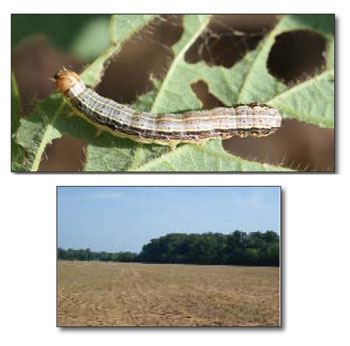ALERT – Fall Armyworms In Soybean
JACKSON, TENN.
When the stars align, fall armyworm larvae can completely defoliate soybean. The common scenario … larvae infest grassy weeds in late planted or double cropped fields and then move onto the soybean plants, especially if Round-Up or some other herbicide is used to take out the grasses. With the recent rains, there has been a flush of grasses in some soybean fields, and I’ve seen and had a few reports of fall armyworms on these grasses. They are also occurring in pastures.

Fall Armyworm Soybean Field Completely Defoliated by Fall Armyworms
photo by Philip Shelby, early August 2010
Scouting is in order! Concentrate on late planted fields and especially any fields with grassy weeds including volunteer wheat. Beware if you sprayed grassy fields with herbicide in the last 7-10 days because this will push the larvae onto the soybean plants all at once. Scout any grassy spots, and you can even sweep the grasses to see if larvae are present. Remember – they will typically start on the grasses and may only be present on soybean in low numbers until the grasses are almost gone.
The “grass strain” of fall armyworm larvae tend to be green or grayish in color. On rare occasions, fields can be completely defoliated within a week. The good news is that this grass strain is easy to kill with insecticides. Synthetic pyrethroids at mid to high rates will provide excellent control (e.g., Asana XL, Baythroid XL, Brigade, Karate, Mustang Max, etc.). Belt SC, Intrepid, Steward and Tracer will also provide excellent control. Treatment is recommended when more than 30 percent defoliation is observed or if 9 or more larvae are found per 25 sweep (3-4 larvae per foot of row). However, don’t wait to treat if weedy grasses are common and crawling with larvae. This is almost always just a one-spray problem when it occurs. Δ
DR. SCOTT STEWART: IPM Extension Specialist, University of Tennessee